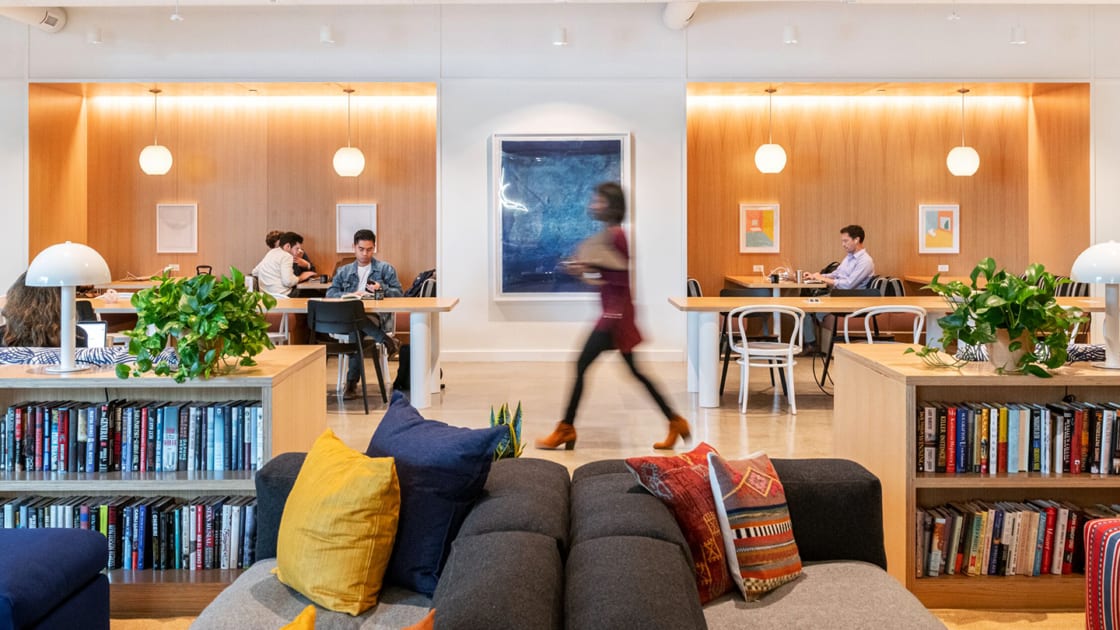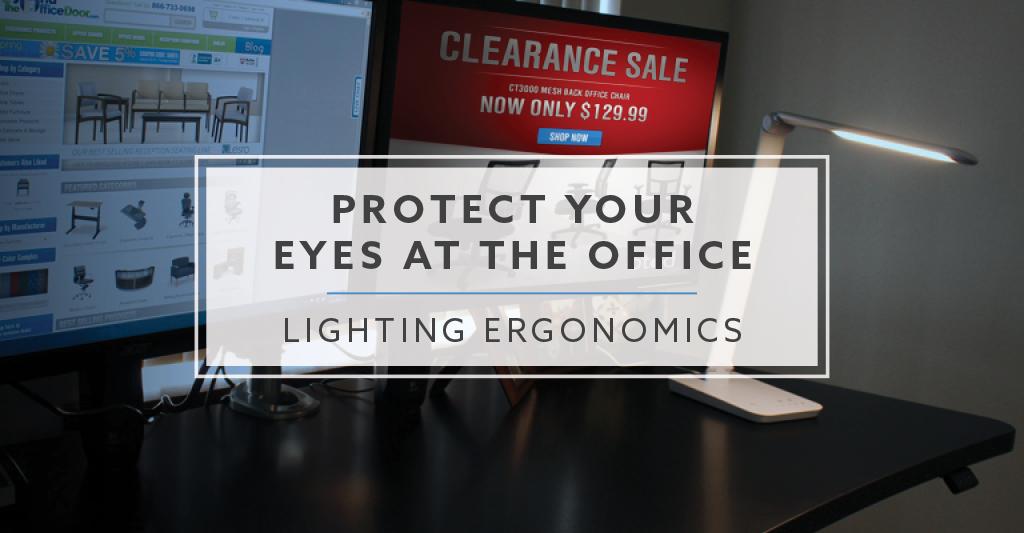There are many factors to consider when choosing the best office lighting for your eyes. The amount of light, the type of light, and the direction of light all play a role in how well your eyes will be able to see. The amount of light is important because too much light can cause glare and make it difficult to see.
Too little light can also make it difficult to see, so you’ll want to find a balance that is comfortable for your eyes. The type of light is also important because some types of light can be harsher on your eyes than others. Fluorescent lights are often considered to be the most eye-friendly, but LED lights are becoming more popular as they are more energy-efficient.
The direction of light is also important as overhead lighting can create shadows that make it difficult to see.
There are a few things to consider when it comes to finding the best office lighting for the eyes. The first is the type of lightbulb you choose. LED bulbs are a great option because they emit very little blue light, which has been linked to eye strain and even sleep problems.
You’ll also want to make sure that your light source is at a comfortable height so you’re not constantly looking up or down while you work. Another thing to keep in mind is the color of your walls and ceiling. If they’re dark, you might want to consider painting them a lighter color to help reflect some of the light and reduce eye fatigue.
And finally, if possible, try to get some natural light into your office space during the day. Even just 30 minutes of exposure can help reduce eye strain and improve your overall mood and energy levels.

Credit: www.wework.com
Which Light is Good for Eyes in Office?
There are a few things to consider when choosing which light is good for eyes in office. The first is the intensity of the light. You want to make sure that the light is not too bright or too dim.
The second is the color of the light. You want to make sure that the light is not too blue or too yellow. The third is the direction of the light.
You want to make sure that the light hits your eye at an angle that is comfortable for you.
What Lighting is Easiest on the Eyes?
There are a few different types of lighting that are easier on the eyes than others. One type is natural light, which can be either from the sun or from artificial sources like lamps and overhead lights. This type of light is less likely to cause eye strain because it doesn’t have the same harsh glare as other types of light.
Another type of lighting that is easy on the eyes is diffused light. This type of light has been scattered so that it isn’t as concentrated in one area. This makes it easier to see without causing as much eye strain.
Finally, indirect lighting is also easy on the eyes. This type of lighting illuminates an area indirectly, instead of directly shining into your eyes. This helps to reduce eye strain and makes it easier to see for extended periods of time.
What is the Best Lighting for Working on a Computer?
If you do a lot of work on your computer, you probably want to have the best lighting possible. There are a few things to consider when choosing the right lighting for working on your computer.
First, you’ll want to make sure that the light is not too bright or too dim.
You don’t want the light to be so bright that it’s blinding, but you also don’t want it to be so dim that you can’t see your screen clearly.
Second, you’ll want to choose a light source that is not too harsh. Harsh lighting can cause eye strain, so you’ll want to avoid it if possible.
Instead, look for a softer light source that will be easier on your eyes.
Third, you’ll want to make sure that the light is not going to create any glare on your screen. Glare can be very distracting and make it difficult to see your screen clearly.
If possible, find a light source that is behind you instead of in front of you so that there is no chance of glare.
Overall, there is no one perfect answer for what the best lighting is for working on a computer. It really depends on your personal preference and what works best for you in terms of brightness, color temperature, and position relative to your screen.
Is Led Lighting Better for Your Eyes?
There are many benefits to LED lighting, including that it is more energy-efficient and has a longer lifespan than traditional incandescent bulbs. But one of the most compelling reasons to switch to LED lighting is for the sake of your eyesight.
LED lights emit very little UV radiation, unlike incandescent bulbs which emit a significant amount.
This means that you are less likely to experience eye strain and other problems associated with exposure to UV light when using LEDs.
In addition, LED lights produce a very bright, clear light which is much easier on the eyes than the dimmer, yellowish light of an incandescent bulb. This can help to reduce eye fatigue and make it easier to see when working or studying in low-light conditions.
So if you’re looking for a type of lighting that is kinder to your eyes, switch to LEDs! You’ll notice the difference right away.
Best Home Office Lighting for Computer Work and Programming
Best Home Office Lighting for Computer Work
If you work from home or spend a significant amount of time at your computer, then it’s important to have good lighting. The type of lighting that’s best for computer work is called “task lighting.” Task lighting is a focused light source that illuminates the specific area where you’re working.
There are a few things to keep in mind when choosing task lighting for your home office. First, the light should be bright enough to help you see what you’re doing, but not so bright that it causes eye strain. Second, the light should be adjustable so you can position it exactly where you need it.
And finally, the light should be free of glare and flicker, which can both cause headaches and eye fatigue. Here are a few different types of task lights that would work well in a home office: Desk lamps: Desk lamps are one of the most popular choices for task lighting because they’re affordable and easy to use.
Look for a lamp with an adjustable arm so you can position the light exactly where you need it. And make sure the shade is opaque so there’s no glare or flicker. Fluorescent lights: Fluorescent lights are another good option for task lighting because they’re very bright and energy-efficient.
However, they can also produce a lot of glare and flicker, so make sure to buy a fixture that has a special anti-glare coating. LED lights: LED lights are becoming increasingly popular as task lights because they’re very energy-efficient and long-lasting. They also emit very little heat, making them ideal for use in close quarters like a home office.
Office Lighting for Sensitive Eyes
If you have sensitive eyes, you know how important it is to have good office lighting. Poor office lighting can cause eye fatigue, headaches, and even migraines. So what are the best office lighting options for those with sensitive eyes?
Fluorescent Lighting: Fluorescent lighting is often used in offices because it is bright and efficient. However, fluorescent lights can also be very harsh on the eyes. If you have sensitive eyes, try to avoid working under fluorescent lights if possible.
If you can’t avoid it, make sure to take breaks often and blink frequently to help reduce eye strain.
Natural Light: Natural light is always the best option for your eyes. If possible, try to set up your desk near a window so you can take advantage of natural light during the day.
Not only will this help reduce eye strain, but it will also give you a much-needed break from staring at artificial lights all day long.
LED Lighting: LED lighting is becoming increasingly popular in offices because it is more energy-efficient than other types of lighting. However, LED lights can also be quite harsh on the eyes.
If you’re looking for an energy-efficient option that won’t put too much strain on your eyes, look for LEDs with a high color rendering index (CRI).
Best Lighting to Avoid Eye Strain
When it comes to choosing the best lighting to avoid eye strain, there are a few things you’ll want to keep in mind. First, try to avoid fluorescent lights when possible. These can cause a glare that can be tough on the eyes.
Instead, opt for incandescent or LED lighting.
Next, you’ll want to make sure the light is not too bright or too dim. You don’t want to strain your eyes by squinting in a bright room or by straining to see in a dark one.
The ideal light level will depend on the task you’re doing and your own personal preferences, so experiment until you find what works best for you.
Finally, pay attention to the color of the light. Some people prefer cooler tones while others find warmer ones more soothing.
Again, it’s all about personal preference so take some time to experiment until you find what works best for you.
Best Lighting for Office
The best lighting for an office depends on the type of work that is done there. For example, if workers are constantly staring at computer screens, then they will need a lot of light that does not cause glare. If workers are handling paperwork or other materials, then they will need more diffuse light so that they can see what they are doing.
The best way to determine the best lighting for an office is to ask the employees what would work best for them.
Conclusion
The
If you’re looking for the best office lighting for your eyes, there are a few things to keep in mind. First, make sure that the light source is not directly in your line of sight.
Second, use a diffuser to soften the light and reduce glare. And third, choose a light source with a color temperature that’s close to natural daylight.

